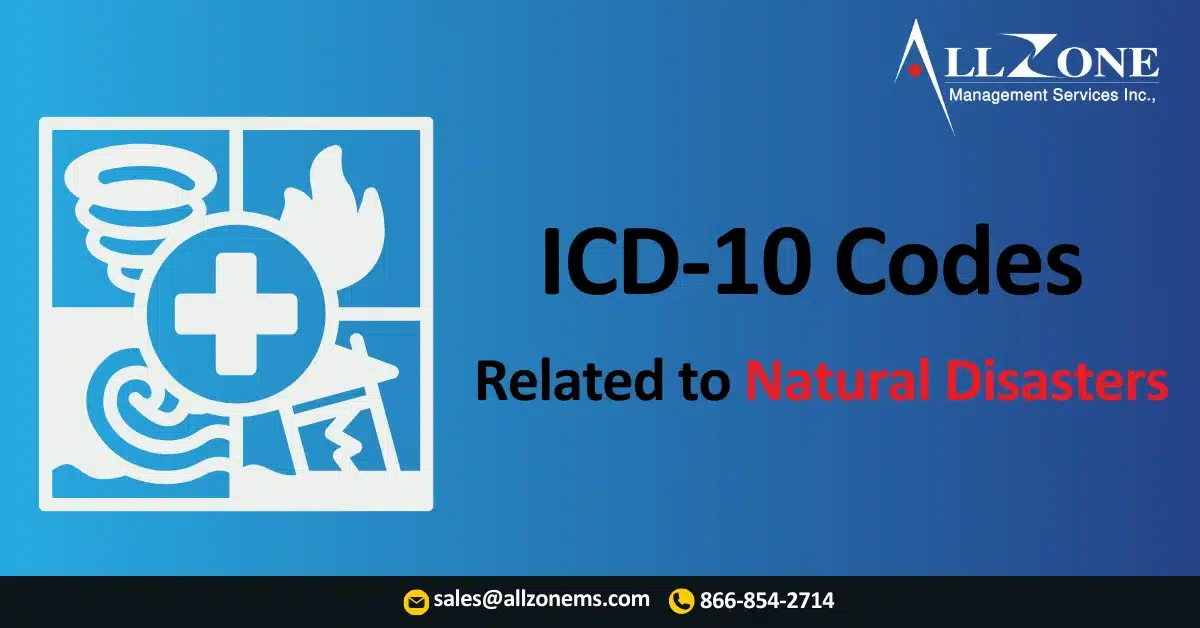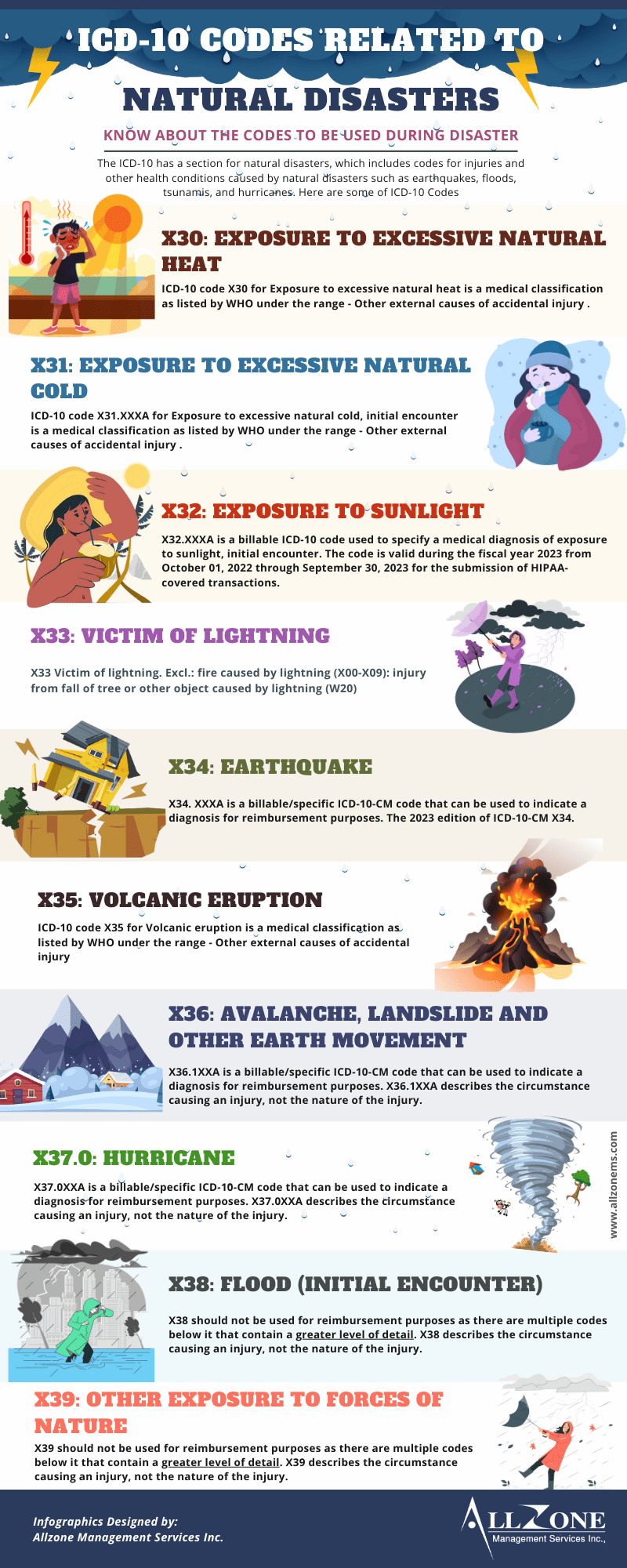The International Classification of Diseases, 10th Revision (ICD-10), is a standardized medical classification system developed by the World Health Organization (WHO). It categorizes diseases, injuries, and other health conditions, including ICD-10 Codes for Natural Disasters.
For natural disasters, the ICD-10 provides specific codes to classify related injuries and health issues.
Here are some of the most common ICD-10 codes for natural disasters:
1. Exposure to Forces of Nature (X30-X39):
Covers a wide range of natural disasters, including earthquakes, floods, hurricanes, and tornadoes. Examples:
-
- X30: Exposure to excessive natural heat
- X31: Exposure to excessive natural cold
- X32: Exposure to sunlight
- X33: Victim of lightning
- X34: Earthquake
- X35: Volcanic eruption
- X36: Avalanche, landslide, and other earth movement
- X37: Hurricane
- X38: Storm, tropical cyclone, flood
- X39: Other exposure to forces of nature
2. Accidental Falls (W00-W19):
Includes falls caused by natural disasters like landslides or mudslides. Examples:
-
- W00: Accidental fall from a high place
- W01: Accidental fall from a lower level
- W02: Accidental fall from unspecified height
3. Accidental Drowning and Submersion (W65-W74):
Covers drowning or submersion due to natural disasters such as floods or tsunamis. Examples:
-
- W65: Drowning and submersion
- W66: Asphyxia due to immersion in water
- W67: Asphyxia due to inhalation of gastric contents following drowning
- W68: Other asphyxia due to drowning
- W69: Sequelae of drowning and submersion
4. Exposure to Fire and Flames (X00-X09):
Includes exposure to fire and flames caused by natural disasters like wildfires. Examples:
-
- X00: Exposure to fire and flames, undetermined whether accidental or caused by intent
- X01: Exposure to fire and flames, accidental
- X02: Exposure to fire and flames, caused by intent
5. Exposure to Smoke, Fire, and Flames (X40-X49):
Covers exposure to smoke and fumes resulting from natural disasters like wildfires or volcanic eruptions. Examples:
-
- X40: Exposure to smoke and fumes, undetermined whether accidental or caused by intent
- X41: Exposure to smoke and fumes, accidental
- X42: Exposure to smoke and fumes, caused by intent
Beyond Injury Classification:
ICD-10 codes are not just for classifying injuries. They also aid in tracking the public health impact of ICD-10 Codes for Natural Disasters. By analyzing code usage, public health officials can better understand associated health risks and develop effective mitigation strategies.
If you’ve been affected by a natural disaster, it’s crucial to seek medical attention if you’re injured or unwell. Be sure to inform your doctor about the disaster for accurate diagnosis and treatment.
Medical coding companies face unique challenges when dealing with ICD-10 codes for natural disasters. These challenges arise due to the specific nature of these events and the complexities of the ICD-10 coding system.
Challenges for Medical Coding Companies in ICD-10 Coding for Natural Disasters
Here are some of the key challenges:
Medical coding companies face unique challenges when dealing with ICD-10 codes for natural disasters. These challenges arise due to the specific nature of these events and the complexities of the ICD-10 coding system.
1. Specificity and Complexity of ICD-10 Codes
-
- Multiple Codes: Natural disasters often result in a combination of injuries and illnesses, requiring multiple ICD-10 codes to accurately represent the patient’s condition.
- Specificity of Codes: The ICD-10 system is highly specific, demanding detailed information about the nature of the injury or illness. This can be challenging when dealing with mass casualty events where information may be limited or incomplete.
2. Uncommon or Emerging Conditions
-
- New Injuries: Natural disasters can cause unique or uncommon injuries that may not have specific ICD-10 codes. This requires coders to use their best judgment and interpret the codes broadly to capture the essence of the condition.
- Emerging Diseases: In some cases, natural disasters can lead to outbreaks of infectious diseases. Coders must stay updated on the latest guidelines and codes related to these emerging conditions.
3. Documentation Challenges
-
- Incomplete or Inaccurate Documentation: In the immediate aftermath of a natural disaster, medical records may be incomplete or inaccurate due to the chaotic circumstances. This can make it difficult for coders to assign the correct ICD-10 codes.
- Delayed Documentation: Documentation may be delayed due to the overwhelming number of patients or the need to focus on immediate medical care. This can lead to coding delays and potential reimbursement issues.
To address these challenges, medical coding companies often employ specialized teams with expertise in disaster-related coding. They may also utilize coding software and tools that can assist in identifying appropriate codes and ensuring compliance with coding guidelines.


